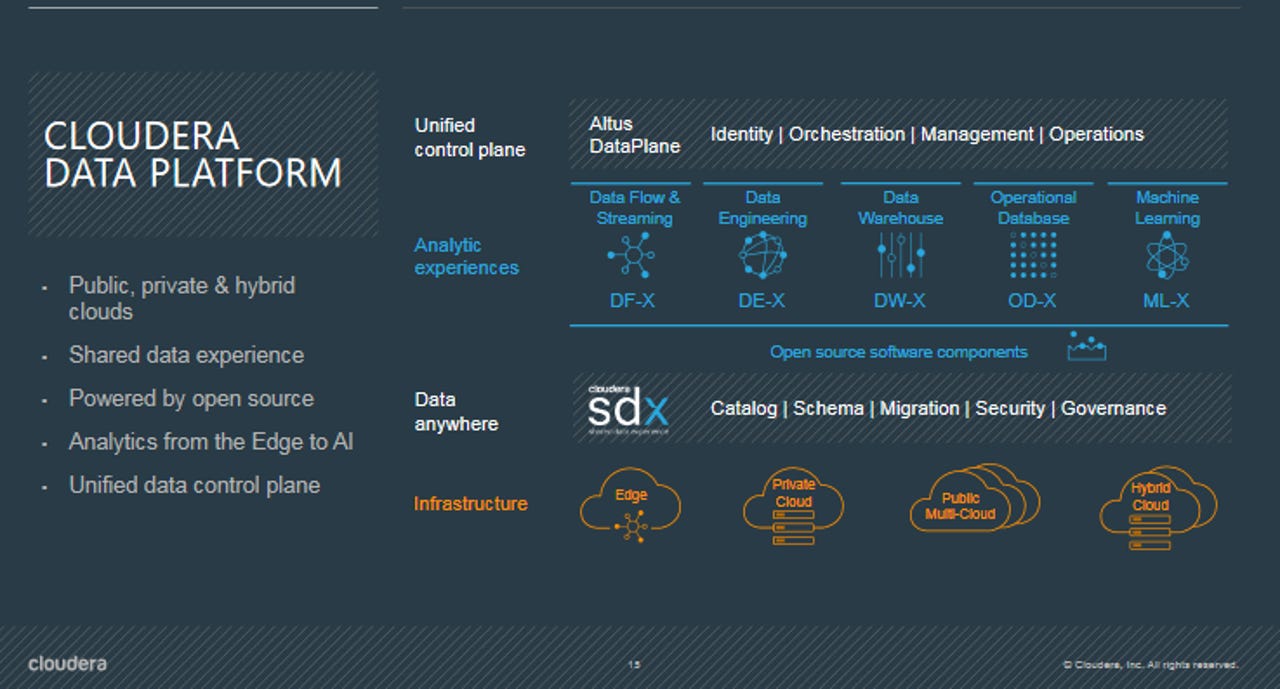Cloudera customers hit brakes on renewals ahead of Cloudera Data Platform, CEO Reilly to retire


Cloudera named Martin Cole interim CEO as Tom Reilly will retire effective July 31. The company also delivered fiscal first quarter sales that fell short of estimates and an outlook that disappointed.
The CEO transition comes as Cloudera closed the Hortonworks acquisition just months ago. Cole will be part of the board member committee conducting a search for the new CEO. Cole had been the head of Accenture's Technology Group before retiring in 2014.
Cloudera reported a first quarter net loss of $103 million, or 38 cents a share, on revenue of $187.5 million. The Hortonworks deal closed Jan. 3 so sales for Cloudera are well ahead of last year. On a non-GAAP basis, Cloudera reported a first quarter loss of 13 cents a share.
Wall Street was looking for a non-GAAP loss of 23 cents a share on revenue of $188.4 million. Shares were hammered 28% in after-hours trading.
Must read
- Cloudera eyes Cloudera Data Platform launch over the next two quarters as AWS competition looms
- The new Cloudera-Hortonworks Hadoop: 100 percent open source, 50 percent boring
- Cloudera's a data warehouse player now
- Cloudera and Hortonworks' merger closes; quo vadis Big Data?
Cloudera's outlook was also dismal. The company projected a second quarter non-GAAP loss of 11 cents a share to 8 cents a share on revenue of $180 million to $183 million. For fiscal 2020, Cloudera projected a non-GAAP loss of 32 cents a share to 28 cents a share on revenue of $745 million to $765 million.
Those projections were well short of revenue estimates. Wall Street consensus for the second quarter was a non-GAAP loss of 10 cents a share on revenue of $202.9 million. For fiscal 2020, Wall Street was looking for a loss of 35 cents a share on revenue of $843.8 million.
Reilly said customers are postponing renewal agreements ahead of the release of the Cloudera Data Platform. Reilly said:
Our enterprise customers are excited about extending their analytic workloads to the public cloud through Cloudera Data Platform, which will be available this summer. While some customers in the first quarter elected to postpone renewal and expansion of their agreements in anticipation of the new platform's release, affecting our full year outlook, this customer feedback and enthusiasm validates demand for enterprise data cloud solutions in our target market.
On a conference call with analysts, Reilly fleshed out those comments a bit and noted that Cloudera was seeing competition from public cloud providers.
In our first quarter as a merged company, we experienced headwinds in bookings from existing customers. These customers generally represent more than 90% of our growth with a focus of the quarter's activities. We've analyzed the challenges we encountered in the quarter and believe the 2 factors primarily contribute to the bookings impact. First, the announcement of our merger in October 2018 created uncertainty particularly regarding the combined company road map, which we rolled out in March of this year. During this period of uncertainty, we saw increased competition from the public cloud vendors. Second, the announcement in March of Cloudera Data Platform, our new hybrid and multi-cloud offering, created significant excitement within our customer base. CDP is compelling as it addresses many of our customers' pressing needs. However, our rapid execution on the Cloudera platform caused customers to wait until release to renew and expand their agreements.
Now the challenge for Cloudera is clear: It can't afford any delays with the Cloudera Data Platform. Product chief Arun Murthy said: "Development of CDP is going remarkably well. The engineering team is laser focused on our vision for the enterprise data cloud. CDP remains on track for availability to customers this summer in the public cloud as a hybrid SaaS offering and later this year as a private cloud offering."
Reilly later elaborated on the competition from public cloud providers.
From the time we announced the merger to where we got our road map, it was about a 5-month period. In that period, our sales force was a bit handicapped without getting clarity of what the road map would be and without that clarity, we were at a competitive disadvantage, and we saw a number of opportunities get taken by the public cloud guys. We've already turned that around because we trained on our road map but now let's say now that customer sees our road map what causes them to pause yet again. They're trying to understand how they would take advantage of CDP, both public and private. It depends on how you're going to move those workloads. It's just a different motion than traditionally just buy more of what they had on-prem.